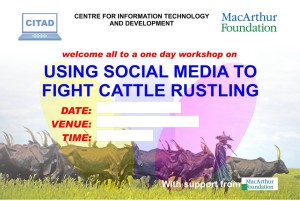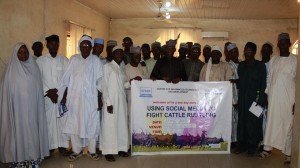REPORT OF ZAMFARA TRAINING ON USE OF SOCIAL MEDIA FOR REPORTING CATTLE RUSTLING
Introduction
Cattle rustling refers to the mass stealing of grazing cattle. It is a situation in which farmers lost cattle to cattle thieves while grazing. Traditionally, cattle rustling have been driven by the criminal intent to expropriate cow for meat or for sale. Pertinently, it must have served as a means of primitive accumulation of cow-herd in the contexts of subsistence and commercial pastoralism. Over the years, cattle rustling have evolved into a pattern of organized crime with immense criminal sophistication and efficiency. Hence, contemporary cattle rustlers operate with modern weaponry and their operations are marked by trans-locational and trans-national syndication. Some of the consequences of cattle rustling include:
- Frequent ethno/religious conflicts with loss of lives
- Increasing spade of violence in the country
- Loss of GDP by affected states
- High social costs to both individuals and the nation
Over the years, cattle rustling in northern Nigeria has become a great issue that is threatening the cattle rearing culture and business associated with it. It has manifested in various scales and dimensions across the regions impending in various strategies and aftermaths.
The Workshop
Considering the aforementioned, the Centre for Information Technology and Development (CITAD) as part of its peace building effort decided to organize a series of one day workshop on using social media to track cattle rustling. The first of the series held on 11th of June 2015 for Fulbe organizations, field cattle rearers, Hardos (Fulani leaders), community leaders etc at Fulbe Hotel, Gusau, Zamfara State. It was attended by representatives from fifteen (15) organizations, including other influential personalities in Zamfara attended the workshop. Some of the organizations were:
- Miyetti-Allah organization, Zamfara state chapter
- Fulbe Development Association
- Fulbe Nane Haame
- Farmers/Fulani Reconciliation Organization
- Dan Sadau Youth Organization
- Voluntary Aid Initiative
- Ministry of Commerce
- Save the Society
- N.U.R.T.W. Zamfara state
- Save Mothers and Children Initiative
- Fulani group
- Initiative for Muslim Women of Nigeria
- Fulani Initiative for Protection of Environment and Less privilege
The objectives of the workshop were:
- To sensitize participants to the use of social media in reporting and tracking cattle rustling
- To initiate a network of  volunteers for tracking and rescuing rustled cattle
- To brief the participants on the Cattle Rustling Information System (CaTRIS) that CITAD is developing to document, track and help to rescue cattle from rustlers.
The workshop started with a background presentation on Using Social Media to Fight Cattle Rustling was taken by CITAD’s Media Officer Malam Sufyan Lawal Kabo. In it, the phenomenon of cattle rustling was presented alongside the Cattle Rustling Information System (CaTRIS). The CaTRI which involve geo-mapping of cattle tracks and grazing reserves on the Ushashidi platform will allow victims to send in information using either text message, whatspps or other forms of social media to the network control centre, which will then broadcast the information using various channels to a network of volunteers who would volunteer to help in locating the rustled cattle. Since the information is geo-referenced, volunteers will have instantaneous idea of where the rustling had taken place and with a geo-mapped of the routes will know the likely routes that the rustles will take in the neighborhood. The system is also going to work with shared codes for people do not know how to write to send in reports using codes and symbols.
The objectives of CaTRIS are:
- To provide rearers with training on use ICTs to send or receive alerts on rustling attempts
- To provide cattle rearers with reporting mechanism should their cattle be taken
- Provide an alert system to provide information to volunteers who will help in tracking stolen cattle
- To document cases of cattle rustling so that we can have a robust database for advocacy purposes
- Provide rearers with the training on use of modern tools that will help in tracking stolen cattle etc.
Following the background presentation, the participants broke into small groups and brainstormed on how the issue of cattle rustling could be addressed. The groups later make presentation of their deliberation as follows:
On the side of government:
- Government should engage Fulani community leaders in designing frameworks for tackling the menace of cattle rustling
- Government should provide good education and other necessities for the Fulani communities
- Government to increase budgetary allocation for the development of grazing reserves
- Government to address the grievance of cattle rustlers
- Government to provide effective security measures in all rearing communities and nomadic routes
- Government should intervene in all rusting cases hanging in courts, police stations and with other security agencies to ensure that justice is done
On the side of CSOs and CBOs
- CSOs to mobilize the Fulani to form self-help organizations and interactive forums that will comprise their fellow rearers and leaders in assisting each other especially on security issues
- Conduct advocacy visits to the government agencies and other stakeholders for the implementation of policies and measures that will solve cattle rustling
- CSOs to volunteer in sensitizing the Fulani on using modern communication technologies in reporting and tracking of stolen cattle
- To collaborate with Fulani traditional rulers, community leaders, youth and women leaders in order to achieve desired objectives
The third item was a hands-on training on use of Whataspp for reporting cattle rustling. This was facilitated by CITAD’s Peace Clubs Officer; Malam Kamilu Isa. He started by first providing a list of lit handset that could download the apps and install, thereafter he assisted some of the participations to install the application in their handset. He then took them through setting up their personal accounts and them making post. A demonstration group, Muftal Fulbe was set up which was then used for the training to illustrate various ways in which the headers could share information as well as report cattle rustling.
The final session was on next steps which was to identify what other follow up activities should follow. It was agreed that there should be advocacy to key stakeholders and sensitization activities among herders. It was also agreed that participants will share the knowledge with others. CITAD will on its own after doing the first round of consultation call review meeting to update the participants on its findings and the state of the CaTRIS.



Leave a Reply